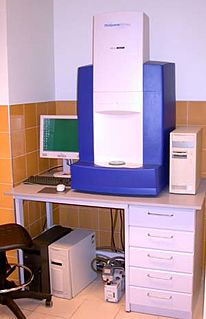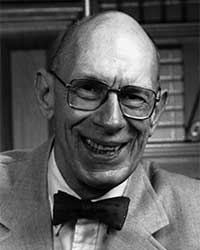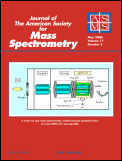
Electrospray ionization (ESI) is a technique used in mass spectrometry to produce ions using an electrospray in which a high voltage is applied to a liquid to create an aerosol. It is especially useful in producing ions from macromolecules because it overcomes the propensity of these molecules to fragment when ionized. ESI is different from other ionization processes since it may produce multiple-charged ions, effectively extending the mass range of the analyser to accommodate the kDa-MDa orders of magnitude observed in proteins and their associated polypeptide fragments.

In mass spectrometry, matrix-assisted laser desorption/ionization (MALDI) is an ionization technique that uses a laser energy absorbing matrix to create ions from large molecules with minimal fragmentation. It has been applied to the analysis of biomolecules and various organic molecules, which tend to be fragile and fragment when ionized by more conventional ionization methods. It is similar in character to electrospray ionization (ESI) in that both techniques are relatively soft ways of obtaining ions of large molecules in the gas phase, though MALDI typically produces far fewer multi-charged ions.

Electron-capture dissociation (ECD) is a method of fragmenting gas-phase ions for structure elucidation of peptides and proteins in tandem mass spectrometry. It is one of the most widely used techniques for activation and dissociation of mass selected precursor ion in MS/MS. It involves the direct introduction of low-energy electrons to trapped gas-phase ions.

The International Mass Spectrometry Foundation (IMSF) is a non-profit scientific organization in the field of mass spectrometry. It operates the International Mass Spectrometry Society, which consists of 37 member societies and sponsors the International Mass Spectrometry Conference that is held once every two years.
Robert Graham Cooks is the Henry Bohn Hass Distinguished Professor of Chemistry in the Aston Laboratories for Mass Spectrometry at Purdue University. He is an ISI Highly Cited Chemist, with over 1,000 publications and an H-index of 134.
Michael T. Bowers is an American mass spectroscopist, a professor in the Department of Chemistry and Biochemistry at the University of California, Santa Barbara faculty.
Fred Warren McLafferty was an American chemist known for his work in mass spectrometry. He is best known for the McLafferty rearrangement reaction that was observed with mass spectrometry. With Roland Gohlke, he pioneered the technique of gas chromatography–mass spectrometry. He is also known for electron-capture dissociation, a method of fragmenting gas-phase ions.

David E. Clemmer is an analytical chemist and the Distinguished Professor and Robert and Marjorie Mann Chair of Chemistry at Indiana University in Bloomington, Indiana, where he leads the Clemmer Group. Clemmer develops new scientific instruments for ion mobility mass spectrometry (IMS/MS), including the first instrument for nested ion-mobility time-of-flight mass spectrometry. He has received a number of awards, including the Biemann Medal in 2006 "for his pioneering contributions to the integration of ion mobility separations with a variety of mass spectrometry technologies."
Michael L. Gross is Professor of Chemistry, Medicine, and Immunology, at Washington University in St. Louis. He was formerly Professor of Chemistry at the University of Nebraska-Lincoln from 1968–1994. He is recognized for his contributions to the field of mass spectrometry and ion chemistry. He is credited with the discovery of distonic ions, chemical species containing a radical and an ionic site on different atoms of the same molecule.

Matrix-assisted laser desorption electrospray ionization (MALDESI) was first introduced in 2006 as a novel ambient ionization technique which combines the benefits of electrospray ionization (ESI) and matrix-assisted laser desorption/ionization (MALDI). An infrared (IR) or ultraviolet (UV) laser can be utilized in MALDESI to resonantly excite an endogenous or exogenous matrix. The term ‘matrix’ refers to any molecule that is present in large excess and absorbs the energy of the laser, thus facilitating desorption of analyte molecules. The original MALDESI design was implemented using common organic matrices, similar to those used in MALDI, along with a UV laser. The current MALDESI source employs endogenous water or a thin layer of exogenously deposited ice as the energy-absorbing matrix where O-H symmetric and asymmetric stretching bonds are resonantly excited by a mid-IR laser.
Dame Carol Vivien Robinson, is a British chemist and former President of the Royal Society of Chemistry (2018–2020). She is a Royal Society Research Professor at the Physical and Theoretical Chemistry Laboratory at the University of Oxford, as well as the Dr Lee's Professor of Physical and Theoretical Chemistry, and a Professorial Fellow at Exeter College. She was previously Professor of Mass Spectrometry at the Department of Chemistry of the University of Cambridge.

Henry M. Fales was an American organic chemist and mass spectrometrist. He authored and co-authored over 350 scientific publications on natural substances and biochemistry and was one of the pioneers in bioanalytical mass spectrometry.

Nicolaas Martinus Maria Nibbering was a Dutch chemist and mass spectrometrist. He was a member of the Royal Netherlands Academy of Arts and Sciences and a recipient of the Thomson Medal and the Joannes Marcus Marci Award.

Frank Henry Field was an American chemist and mass spectrometrist known for his work in the development of chemical ionization.

John H. Beynon FRS was a Welsh chemist and physicist known for his work in mass spectrometry.
The Biemann Medal is awarded annually by the American Society for Mass Spectrometry (ASMS) to an individual early in his or her career in recognition of significant achievement in basic or applied mass spectrometry. It is named after professor Klaus Biemann.
Richard M. Caprioli is an American chemist known for his contributions to mass spectrometry imaging.
Alison E Ashcroft is a British chemist and Emeritus Professor of Biomolecular Mass Spectrometry at the University of Leeds. Her work is focused on method development in mass spectrometry to study protein folding and protein aggregation in relation to diseases.

Julia Laskin is the William F. and Patty J. Miller Professor of Analytical Chemistry at Purdue University. Her research is focused on the fundamental understanding of ion-surface collisions, understanding of phenomena underlying chemical analysis of large molecules in complex heterogeneous environments, and the development of new instrumentation and methods in preparative and imaging mass spectrometry.











